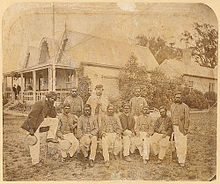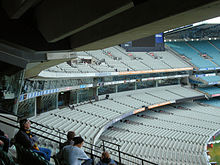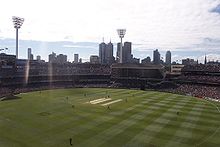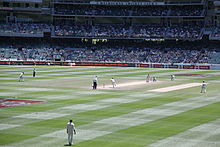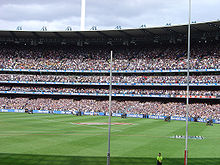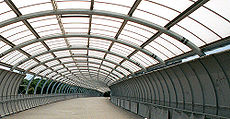- Melbourne Cricket Ground
-
"MCG" redirects here. For other uses, see MCG (disambiguation).
Melbourne Cricket Ground The MCG 
Location Melbourne Park, Melbourne Coordinates 37°49′12″S 144°59′0″E / 37.82°S 144.983333°ECoordinates: 37°49′12″S 144°59′0″E / 37.82°S 144.983333°E Opened 1854 Owner Government of Victoria Operator Melbourne Cricket Club Surface Grass (Oval) Construction cost $150,000,000 (1992 Southern stand redevelopment)
$445,000,000 (2006 Northern stand redevelopment)Architect Various Capacity 100,018 Record attendance 121,696 (1970 VFL Grand Final – Carlton v Collingwood) Field dimensions 171 m x 146 m[1] Tenants Australia national cricket team
Victorian Bushrangers
Melbourne Stars
Collingwood Football Club
Hawthorn Football Club
Melbourne Football Club
Richmond Football ClubThe Melbourne Cricket Ground (MCG) is an Australian sports stadium located in Yarra Park, Melbourne and is home to the Melbourne Cricket Club. It is the eighth largest stadium in the world, the largest in Australia, the largest stadium for playing cricket, and holds the world record for the highest light towers at any sporting venue. The MCG is within walking distance of the city centre and is serviced by the Richmond railway station, Richmond and the Jolimont railway station, East Melbourne. It is part of the Melbourne Sports and Entertainment Precinct.
Internationally, the MCG is remembered as the centrepiece stadium of both the 1956 Summer Olympics and the 2006 Commonwealth Games. The open-air stadium is also one of the world's most famous cricket venues, with the well-attended Boxing Day Test match commencing on Boxing Day (26 December) each year. Throughout the winter, it serves as the home of Australian rules football, with at least one game (though usually more) held there each round. The stadium fills to capacity for the AFL Grand Final in late September, or early October.
The MCG, often referred to by locals as "The G",[2] has also hosted other major events, including International Rules between the Australian Football League (AFL) and Gaelic Athletic Association, international Rugby union, State of Origin rugby league, FIFA World Cup qualifiers and International Friendly matches, serves as the finish line for the Melbourne Marathon and also major rock concerts.
Until the 1970s, more than 120,000 people sometimes crammed into the venue – the record crowd standing at around 130,000 for a Billy Graham evangelistic crusade in 1959, followed by 121,696 for the 1970 VFL Grand Final. Redevelopments have now limited the maximum seating capacity to just over 100,000. This makes it the eighth largest stadium in the world.
The MCG is listed on the Victorian Heritage Register[3] and was included on the Australian National Heritage List on 26 December 2005.[4] On 30 January 2009, the MCG was named as one of the seven wonders of the sporting world.[5] It is referred to within Victoria as the "Spiritual Home of Australian Sport".
Contents
Early history
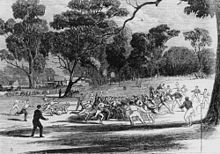 A game at the Richmond Paddock in the 1860s. A pavilion at the MCG is on the left in the background. (A wood engraving made by Robert Bruce on 27 July 1866.)
A game at the Richmond Paddock in the 1860s. A pavilion at the MCG is on the left in the background. (A wood engraving made by Robert Bruce on 27 July 1866.)
Founded in November 1838 the Melbourne Cricket Club (MCC) selected the current MCG site in 1853 after previously playing at several grounds around Melbourne. The club’s first game was against a military team at the Old Mint site, at the corner of William and Latrobe Streets. Burial Hill (now Flagstaff railway station) became its home ground in January 1839, however, the area was already set aside for Botanical Gardens and the club was moved on in October 1846, to an area on the south bank of the Yarra about where the Herald and Weekly Times building is today. Unfortunately the area was subject to flooding forcing the club to move again, this time to a ground in South Melbourne.
It was not long before the club was forced out again, this time because of the expansion of the railway. The South Melbourne ground was in the path of Victoria’s first steam railway line from Melbourne to Sandridge (now Port Melbourne). Governor La Trobe offered the MCC a choice of three sites; an area adjacent to the existing ground, a site at the junction of Flinders and Spring Streets or a ten-acre (about 4 hectares) section of the Government Paddock at Richmond next to Richmond Park.
This last option, which is now Yarra Park, had been used by Aborigines until 1835. Between 1835 and 1853 it was an agistment area for colonial troopers’ horses. In 1850 it was part of a 200-acre (81 ha) stretch set aside for public recreation extending from Governor La Trobe’s Jolimont Estate to the Yarra River. By 1853 it had become a busy promenade for Melbourne residents.
An MCC sub-committee chose the Richmond Park option because it was level enough for cricket but sloped enough to prevent inundation. That ground was located where the Richmond, or outer, end of the current MCG is now.
At the same time the Richmond Cricket Club was given occupancy rights to six acres (2.4 hectares) for another cricket ground on the eastern side of the Government Paddock.
At the time of the land grant the Government stipulated that the ground was to be used for cricket and cricket only. This condition remained until 1933[citation needed] when the State Government allowed the MCG’s uses to be broadened to include other purposes when not being used for cricket.
In 1863 a corridor of land running diagonally across Yarra Park was granted to the Hobson’s Bay Railway and divided Yarra Park from the river. The area closest to the river was also developed for sporting purposes in later years including Olympic venues in 1956.
Stadium development
The first grandstand at the MCG was the original wooden members’ stand built in 1854, while the first public grandstand was a 200-metre long 6000-seat temporary structure built in 1861. Another grandstand seating 2000 and facing one way to the cricket ground and the other way to the park where football was played, was built in 1876 for the 1877 visit of James Lillywhite’s English cricket team. It was during this tour that the first Test Match was played.
In 1881 the original members’ stand was sold to the Richmond Cricket Club for £55. A new brick stand, considered at the time to be the world’s finest cricket facility, was built in its place. The foundation stone was laid by Prince George of Wales and Prince Albert Victor on 4 July and the stand opened in December that year. It was also in 1881 that a telephone was installed at the ground, and the wickets and goal posts were changed from an east-west orientation to north-south. In 1882 a scoreboard was built which showed details of the batsman's name and how he was dismissed.
When the Lillywhite tour stand burnt down in 1884 it was replaced by a new stand which seated 450 members and 4500 public. In 1897 second storey wings were added to ‘The Grandstand’, as it was known, increasing capacity to 9,000 and in 1900 it was lit with electric light.
More stands were built in the early 20th Century. An open wooden stand was on the south side of the ground in 1904 and the 2084-seat Grey Smith Stand (known as the New Stand until 1912) was erected for members in 1906. The 4000-seat Harrison Stand on the ground’s southern side was built in 1908 followed by the 8000-seat Wardill Stand in 1912. In the 15 years after 1897 the stand capacity at the ground increased to nearly 20,000.
In 1927 the second brick members’ stand was replaced at a cost of £60,000. The Harrison and Wardill Stands were demolished in 1936 to make way for the Southern Stand which was completed in 1937. The Southern Stand seated 18,200 under cover and 13,000 in the open and was the main public area of the MCG. It was where the famous Bay 13 was located, the MCG’s equivalent to The Hill at the Sydney Cricket Ground.
The Northern (Olympic) Stand replaced the old Grandstand for the 1956 Olympic Games and ten years later the Grey Smith Stand and the open concrete stand next to it were replaced by the Western (now Ponsford) Stand.
On 3 March 1967 the Duke of Edinburgh laid a foundation stone for a new Western Stand, which was completed in 1968 (known as the Ponsford Stand after 1986).
The MCG was the home of Australia’s first full colour video scoreboard which replaced the old scoreboard in 1982. In 1985 light towers were installed at the ground, allowing for night football and day-night cricket games.
In 1988 inspections of the old Southern Stand found concrete cancer and provided the opportunity to replace the increasingly run-down 50-year-old facility. The projected cost of $100 million was outside what the Melbourne Cricket Club could afford so the Victorian Football League took the opportunity to part fund the project in return for a 30-year deal to share the ground. The new Great Southern Stand was completed in 1992 at a final cost of $150 million.
The 1928 Members' stand, as well as the 1956 Olympic stand and the 1968 Ponsford stand were demolished one by one between late 2003 to 2005. They were replaced with a new structure in time for Melbourne to host the 2006 Commonwealth Games. Despite now standing as a single unbroken stand, the individual sections retain the names of Ponsford, Olympic and Members Stands. The redevelopment cost exceeded A$400 million and pushed the ground's capacity over the 100,000 mark. Since redevelopment, the highest attendance was the 2010 Grand Final of the AFL with 100,016.
On 3 September 2009, it was announced by the Melbourne Cricket Club and the Victorian Government that a $30 million refurbishment of the Great Southern Stand would take place. The refurbishment will include renovations to entrance gates which will include more streamlined ticketing areas, food and beverage outlet upgrades including basement level outlets, possible upgrades to seating, public concourses as well as the refurbishment of toilets, function rooms and dining rooms. The upgrade commitment was confirmed on 15 September 2010 with the Melbourne Cricket Club injecting an extra $25 million to bring the upgrade budget to $55 million. Refurbishment will begin during June 2011 and will be completed by March 2013. The upgrade dismisses rumours that for the time being the Great Southern Stand would be demolished and rebuilt in a similar fashion to the combined Ponsford, Members and Olympic stands.[6]
Cricket
Early years
The first cricket match was played on 30 September 1854.
The first inter-colonial cricket match to be played at the MCG was between Victoria and New South Wales in March 1856. Victoria had played Tasmania as early as 1851 but the Victorians had included two professionals in the 1853 team upsetting the Tasmanians and causing a cooling of relations between the two colonies. To replace the disgruntled Tasmanians the Melbourne Cricket Club issued a challenge to play any team in the colonies for £1000. Sydney publican William Tunks accepted the challenge on behalf of New South Wales although the Victorians were criticised for playing for money. Ethics aside, New South Wales could not afford the £1000 and only managed to travel to Melbourne after half the team’s travel cost of £181 was put up by Sydney barrister Richard Driver.
The game eventually got under way on 26 March 1856. The Victorians, stung by criticism over the £1000 stake, argued over just about everything; the toss, who should bat first, whether different pitches should be used for the different innings and even what the umpires should wear.
Victoria won the toss but New South Wales captain George Gilbert successfully argued that the visiting team should decide who bats first. The MCG was a grassless desert and Gilbert, considering players fielded without boots, promptly sent Victoria into bat. Needing only 16 to win in the final innings, New South Wales collapsed to be 5 for 5 before Gilbert’s batting saved the game and the visitors won by three wickets.
In subsequent years conditions at the MCG improved but the ever-ambitious Melburnians were always on the lookout for more than the usual diet of club and inter-colonial games. In 1861, Felix William Spiers and Christopher Pond, the proprietors of the Cafe de Paris in Bourke Street and caterers to the MCC, sent their agent, W.B. Mallam, to England to arrange for a cricket team to visit Australia.
Mallam found a team and, captained by Heathfield Stephenson, it arrived in Australia on Christmas Eve 1861 to be met by a crowd of more than 3000 people. The team was taken on a parade through the streets wearing white-trimmed hats with blue ribbons given to them for the occasion. Wherever they went they were mobbed and cheered by crowds to the point where the tour sponsors had to take them out of Melbourne so that they could train undisturbed.
Their first game was at the MCG on New Year’s Day 1862, against a Victorian XVIII. The Englishmen also wore coloured sashes around their waists to identify each player and were presented with hats to shade them from the sun. Some estimates put the crowd at the MCG that day at 25,000. It must have been quite a picture with a new 6000 seat grandstand, coloured marquees ringing the ground and a carnival outside. Stephenson said that the ground was better than any in England. The Victorians however, were no match for the English at cricket and the visitors won by an innings and 96 runs.
Over the four days of the ‘test’ more than 45,000 people attended and the profits for Speirs and Pond from this game alone was enough to fund the whole tour. At that time it was the largest number of people to ever watch a cricket match anywhere in the world. Local cricket authorities went out of their way to cater for the needs of the team and the sponsors. They provided grounds and sponsors booths without charge and let the sponsors keep the gate takings. The sponsors however, were not so generous in return. They quibbled with the Melbourne Cricket Club about paying £175 for damages to the MCG despite a prior arrangement to do so.
The last match of the tour was against a Victorian XXII at the MCG after which the English team planted an elm tree outside the ground.
Following the success of this tour, a number of other English teams also visited in subsequent years. George Parr’s side came out in 1863–64 and there were two tours by sides led by W.G. Grace. The fourth tour was led by James Lillywhite.
First test match
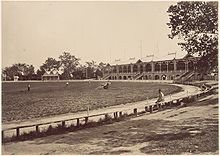 The MCG in 1878. The first Test cricket match was played at the MCG in 1877
The MCG in 1878. The first Test cricket match was played at the MCG in 1877
Up until the fourth tour in 1877, led by Lillywhite, touring teams had played first-class games against the individual colonial sides, but Lillywhite felt that his side had done well enough against New South Wales to warrant a game against an All Australian team.
When Lillywhite headed off to New Zealand he left Melbourne cricketer John Conway to arrange the match for their return. Conway ignored the cricket associations in each colony and selected his own Australian team, negotiating directly with the players. Not only was the team he selected of doubtful representation but it was also probably not the strongest available as some players had declined to take part for various reasons. Demon bowler Fred Spofforth refused to play because wicket-keeper Billy Murdoch was not selected. Paceman Frank Allan was at Warnambool Agricultural Show and Australia’s best all-rounder Edwin Evans could not get away from work. In the end only five Australian-born players were selected.
The same could be said for Lillywhite’s team which, being selected from only four counties, meant that some of England’s best players did not take part. In addition, the team had a rough voyage back across the Tasman Sea and many members had been seasick. The game was due to be played on 15 March, the day after their arrival, but most had not yet fully recovered. On top of that, wicket-keeper Ted Pooley was still in a New Zealand prison after a brawl in a Christchurch pub.
England were nonetheless favourites to win the game and the first ever Test match began with a crowd of only 1000 watching. The Australians elected Dave Gregory from New South Wales as Australia’s first ever captain and on winning the toss he decided to bat.
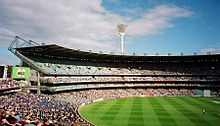 A view of the Great Southern Stand during the 1998 Boxing Day Test match. The Olympic Stand (now demolished) is visible at the bottom left of the photo
A view of the Great Southern Stand during the 1998 Boxing Day Test match. The Olympic Stand (now demolished) is visible at the bottom left of the photo
Charles Bannerman scored an unbeaten 165 before retiring hurt. Sydney Cricket Ground curator, Ned Gregory, playing in his one and only Test for Australia, scored Test cricket’s first duck. Australia racked up 245 and 104 while England scored 196 and 108 giving Australia victory by 45 runs. The win hinged on Bannerman’s century and a superb bowling performance by Tom Kendall who took of 7 for 55 in England’s second innings.
A fortnight later there was a return game, although it was really more of a benefit for the English team. Australia included Spofforth, Murdoch and T.J.D. Cooper in the side but this time the honours went to England who won by four wickets.
Two years later Lord Harris brought another England team out and during England’s first innings in the Test at the MCG, Fred Spofforth took the first hat-trick in Test cricket. He bagged two hauls of 6 for 48 and 7 for 62 in Australia’s ten wicket win.
Later cricket
On Boxing Day 1866 an Indigenous Australian cricket team played at the MCG with 11,000 spectators against an MCC team. A few players in that match were in a later team that toured England in 1868. Some also played in three other matches at the ground before 1869.
By the 1880s the tradition of England-Australia cricket tours was well established, with a total of eight Tests having been played, five of them at the MCG, two at the Sydney Cricket Ground and one at The Oval in London. In 1882, England lost to a visiting Australian team in England for the first time. The match was played at The Oval in August on what was said to be a difficult pitch. Australian bowler Fred Spofforth decimated the English batting after a shocking start by the Australians and the result was a nailbiting finish in which Australia won by seven runs – still one of the closest finishes in Test cricket history. The defeat was widely recorded in the English press and a mock obituary was published in The Sporting Times, lamenting the death of English cricket and noted that "the body will be cremated and the ashes taken to Australia".
A domestic one-day match being played under floodlights.
Later that year, the Honourable Ivo Bligh led a team of eight amateurs and four professionals to Australia to recover them, with the first two matches of the tour played at the MCG. The first[7] being a timeless match (as was the custom in those days) that commenced on 30 December. On New Year's Day the attendance was 23,000, and Australia won the match by nine wickets in three days. The second match[8] commenced on 19 January 1883 and was won comfortably by England by an innings and 27 runs.
Two further matches were played by the tourists in Sydney, with the first being won by England and the second by Australia. The second Sydney match was subsequently deemed to not be of Test status, so England had won with the series and had "recovered The Ashes" as Bligh had set out to do. A group of Melbourne women presented Bligh with a small urn and the Ashes tradition was then firmly established.
Donald Bradman's record at the MCG is an average of 128 runs in 17 innings. In the 11 Tests that he played there, he made at least one century in nine of them.
Australia’s highest first class score was posted at the MCG when Victoria made 1107 against New South Wales in 1926–27. Jack Ryder scored 295 for the Vics and hit six sixes in the process.
Highlights and lowlights
One of the most sensational incidents in Test cricket occurred at the MCG during the Melbourne test of the 1954–55 England tour of Australia. Big cracks had appeared in the pitch during a very hot Saturday’s play and on the rest day Sunday, groundsman Jack House watered the pitch to close them up. This was illegal and the story was leaked by The Age newspaper. The teams agreed to finish the match and England won by 128 runs after Frank Tyson took 7 for 27 in the final innings.
An incident in the second Test of the 1960–61 series involved the West Indies player Joe Solomon being given out after his hat fell on the stumps after being bowled at by Richie Benaud. The crowd sided with the West Indies over the Australians.
Not only was the first Test match played at the MCG, the first One Day International match was also played there, on 5 January 1971, between Australia and England. Australia won the 40-over match by 5 wickets. The next ODI was played on August 1972, some 19 months later.[9]
In March 1977, the Australian Cricket Board assembled 218 of the surviving 224 Australia-England players for a Test match to celebrate 100 years of Test cricket between the two nations. The match was the idea of former Australian bowler and MCC committee member Hans Ebeling who had been responsible for developing the cricket museum at the MCG.
The match had everything. England’s Derek Randall scored 174, Australia’s Rod Marsh also got a century, Lillee took 11 wickets, and David Hookes, in his first test, smacked five fours in a row off England captain Tony Greig’s bowling. Rick McCosker who opened for Australia suffered a fractured jaw after being hit by a sharply rising delivery. He left the field but came back in the second innings with his head swathed in bandages. Incredibly Australia won by 45 runs, exactly the same margin as the first test in 1877.
A less savoury incident occurred in 1981 when Indian batsmen Sunil Gavaskar and Chetan Chauhan walked off the field in a test against Australia. Gavaskar was unhappy with the umpire’s decision to give him out lbw.
A more celebrated unsavoury incident occurred on 1 February 1981 at the end of a one-day match between Australia and New Zealand. New Zealand, batting second, needed six runs off the last ball of the day to tie the game. Australian captain, Greg Chappell instructed his brother Trevor, who was bowling the last over, to send the last ball down underarm to prevent the New Zealand batsman, Brian McKechnie, from hitting the ball for six. Although not entirely in the spirit of the game, an underarm delivery was quite legal, so long as the arm was kept straight. The Laws of cricket have since been changed to prevent such a thing happening again. The incident has long been a sore point between Australia and New Zealand. Chappell’s decision was taken against the advice of his vice-captain Rod Marsh and other senior players. On the surface it seems baffling. McKechnie was a tailender who had just come to the crease. His chances of hitting his first ball for six on the vast MCG were apparently nil and even if he did manage to get it over the fence New Zealand would not win but only draw the game. However, the series was tied and draw would mean both teams would have to front up again for another match. Chappell wanted the game and the series finished to give his players a rest. He was taking no chances against McKechnie, a dual cricket and rugby international.
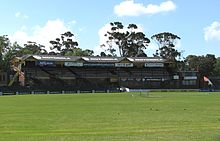 Punt Road Oval, only a few hundred metres to the east of the famous MCG
Punt Road Oval, only a few hundred metres to the east of the famous MCG
In February and March 1985 the Benson & Hedges World Championship of Cricket was played at the MCG, a One Day International tournament involving all of the then Test match playing countries to celebrate 150 years of the Australian state of Victoria. Some matches were also played at Sydney Cricket Ground.
The MCG hosted the historic 1992 Cricket World Cup final between Pakistan and England with a crowd of more than 87,000. Pakistan won the match after sterling all-round performance by Wasim Akram who scored 33 runs and picked up 3 crucial wickets to make Pakistan cricket world champions for the first and as of yet only time. The match was also Imran Khan's last match after which he retired.
During the 1995 Boxing Day Test at the MCG, Australian umpire Darrell Hair called Sri Lankan spin bowler Muttiah Muralitharan for throwing the ball, rather than bowling it, seven times during the match. The other umpires did not call him once and this caused a controversy, although he was later called for throwing by other umpires seven other times in different matches.
 An aerial view of the Melbourne Cricket Ground during the 1992 Cricket World Cup final packed with 87,182 people.
An aerial view of the Melbourne Cricket Ground during the 1992 Cricket World Cup final packed with 87,182 people.
The MCG is known for its great atmosphere, much of which is generated in the infamous Bay 13. In the late 1980s, the warm up stretches performed by Merv Hughes would often be mimicked by the crowd at Bay 13. In a One-Day International cricket match in the late 1990s, the behaviour of Bay 13 was so bad that Shane Warne had to enter the ground from his dressing rooms and tell the crowd to settle down at the request of opposing England captain Alec Stewart.
Highest attendance records for cricket matches at the MCG Number Teams Match type Attendance Date 1 Australia v West Indies Test 90,800 11 February 1961 2 Australia v England Test 89,155 26 December 2006 3 Australia v England Test 87,789 4 January 1937 4 England v Pakistan World Cup Final (day/night) 87,182 25 March 1992 5 Australia v West Indies Benson & Hedges 86,133 22 January 1984 6 Australia v India Twenty20 85,824 1 February 2008 Australian rules football
Origins
See also: Marn Grook and Origins of Australian rules footballDespite being called the Melbourne Cricket Ground, the stadium has been and continues to be used much more often for Australian rules football, which reflects that football is Melbourne's most popular sport, winter or otherwise. Indeed, spectator numbers for football are larger than for any other sport in Australia, and it makes more money for the MCG than any of the other sports played there.
Although the Melbourne Cricket Club members were instrumental in founding Australian Rules Football, there were understandable concerns in the early days about the damage that might be done to the playing surface if football was allowed to be played at the MCG – after all it was a cricket ground. therefore, football games were often played in the parklands next to the cricket ground.
This was the case for the first documented football match to be played at the ground. Noted Melbourne cricketer Thomas Wills wrote a letter to the sporting newspaper, Bell's Life in Victoria, on 10 July 1858, suggesting a football club be formed so cricketers could keep fit during the winter months.
Three weeks later Bell's Life in Victoria published another item reporting that James Bryant, publican of the Parade Hotel (now the Melbourne Cricket Ground Hotel) on Wellington Parade close by Richmond Park, had offered to provide a ball for the next football game to be played.
It wasn’t this offer that kicked off football however, as much as headmasters of Australian schools following the trend in British public schools, introducing the idea of muscular Christianity through sport, and football in particular. Two headmasters, Dr John E. Bromby of Melbourne Church of England Grammar and St. Kilda Grammar’s William C. Northcott, arranged a game of football between their schools in 1858. The game was played on the open area just north of the Melbourne Cricket Ground on 31 July, the week of Bryant’s published offer, and was won by St Kilda Grammar.
The next game was organised between Scotch College and Melbourne Grammar a week later. The game began on Saturday, 7 August and bore little resemblance to Australian Football as it is played today. It would have looked more like the folk football matches played between towns in England to which it owed its heritage. There were no written rules and no umpires. The field was a paddock with no boundaries and trees for goal posts. About 40 players on each side kicked a round leather ball inflated by a pigs bladder. The game commenced about midday, probably with a place kick, and the rules at that time said that the winner was the first team to score two goals. By 5 pm it was getting dark and as both teams had scored only one goal they all had to come back two weeks later on 21 August for the next instalment. Again neither scored and a fortnight later on 4 September both teams returned to continue playing. Again there was no score. The match was declared a draw and that was the end of the first football season. A plaque in Yarra Park, outside the current MCG, incorrectly commemorates this match between Scotch College and Melbourne Grammar as the first. That these first two games could be so quickly organised after Wills’s letter strongly indicates that they probably were not the first football games at all.
It wasn’t until 1869 that football was played on the MCG proper, even though it was only a trial game involving a police team. It was not for another ten years, in 1879, after the formation of the Victorian Football Association, that the first official match was played on the MCG and the cricket ground itself became a regular venue for football. Night matches were even played that year using specially erected light towers.
In those early years the MCG was the home ground of Melbourne Football Club, Australia’s oldest, established in 1859 by the founder of the game itself, Thomas Wills. A founding member of the Victorian Football Association in 1877, Melbourne won five premierships in the early years using the MCG as its home ground. Melbourne originally played in white and were known as the ‘Invincible Whites’ but became the ‘Redlegs’ in 1872 and eventually the ‘Demons’ after World War II.
The first of nearly 2500 Victorian Football League/Australian Football League games to be played at the MCG was on 15 May 1897, with Melbourne beating Geelong 64 to 19.
Several Australian Football League (AFL) clubs use the MCG as their home ground; currently Melbourne, Richmond, Collingwood and Hawthorn. In 1965 Richmond played St Kilda in its first home match at the MCG. In 1985 North Melbourne played its first home game against Collingwood at the MCG. Collingwood played its first home match at the MCG in 1994. Hawthorn played its first home match at the MCG in 2000.
Grand Finals
Since 1902 most grand finals have been played at the MCG. Those that were not included that at the end of the 1924 season. That year the premiership was decided at the end of a round robin series between the top four teams at the end of the home and away rounds. Thus all matches were played at the teams respective home venues. No grand finals were held at the MCG during World War II (the ground was used by the military), and the 1991 grand final was played at Waverley Park because construction of the Great Southern Stand at the MCG had temporarily reduced the ground’s capacity.
The first tied grand final to be played at the MCG was in 1948 when Essendon and Melbourne finished 69-all at the end of time. Essendon had dominated the season and finished well ahead of second placed Melbourne. They also beat Melbourne in the semi-final and were expected to win the grand final. However, Essendon scored an incredible 27 behinds and only seven goals to Melbourne’s 10 goals 9 behinds. To make things worse for Essendon, Melbourne thrashed Essendon by 39 points in the grand final replay the next week.
In 1966 one of the closest grand final results was between St Kilda and Collingwood. St Kilda was playing in only its third grand final since the founding of the club in 1873. They had been well beaten in the grand final the previous year but this year scores were much closer. In fact the scores were level at the end of regulation time when 17-year old Barry Breen mis-kicked towards goal and the ball scraped in for one point, enough to give St Kilda its first flag.
In 1970 the Grand Final between Carlton and Collingwood was watched by 121,696 people, the biggest sporting crowd ever to squeeze into the MCG. Collingwood had skipped out to a 44 point lead by half time and it looked like Carlton was gone, but in the half-time break master coach Ron Barassi told his Carlton players to ‘Handball! Handball! Handball!’ Up until then Australian Rules had been very much a stop-start game with players kicking forward to team mates who took a mark, stopped and kicked again. While handball was purely used as a defensive option. The 1970 grand final changed all that. In the second half Carlton, instead of kicking and marking, ran and handballed to each other moving the ball quickly away from the Collingwood defenders. Carlton’s tactics saw them catch and beat Collingwood and change forever the way the game is played.
The 1977 season saw one of the most remarkable changes in form in the history of the game. Collingwood finished last in the 1976 competition but under new coach Tom Hafey found themselves in the 1977 VFL Grand Final. It was the first grand final to be televised live in Victoria and viewers tuned in to find Collingwood led by 27 points at three-quarter time. But North came back in the final period to kick five unanswered goals and overhaul the Magpies. Collingwood did managed to score one goal in the final quarter, Ross ‘Twiggy’ Dunne kicked it in the final minute to level the scores. The replay was North’s fifth consecutive finals match that year and they won it to take their second premiership.
The MCG and the VFL/AFL
For many years the VFL had an uneasy relationship with the MCG trustees and the Melbourne Cricket Club. Both needed the other, but resented the dependence. The VFL made the first move which brought things to a head by beginning the development of VFL Park at Mulgrave in the 1960s as its own home ground and as a potential venue for future grand finals. Then in 1983, president of the VFL, Alan Aylett started to pressure the MCG Trust to give the VFL a greater share of the money it made from using the ground for football.
In March 1983 the MCG trustees met to consider a submission from Aylett. Aylett said he wanted the Melbourne Cricket Club’s share of revenue cut from 15 per cent to 10 per cent. He threatened to take the following day’s opening game of the season, Collingwood vs Melbourne, away from the MCG. The trustees knew he couldn’t do it, but they agreed to a compromise. The money was held aside until an agreement could be reached.
Different deals, half deals and possible deals were done over the years, with the Premier of Victoria, John Cain, even becoming involved. Cain was said to have promised the VFL it could use the MCG for six months of the year and then hand it back to the MCC, but this never eventuated, as the MCG Trust did not approve it. In the mid 1980s a deal was done where the VFL was given its own members area in the Northern Stand (which is always conspicuously empty, except on Grand Final day).
Against this background of political manoeuvring, in 1985 North Melbourne became the third club to make the MCG its home ground. In the same year, North played in the first night football match at the MCG for almost 110 years, against Collingwood on 29 March 1985.
In 1986, only a month after Ross Oakley had taken over as VFL Commissioner, VFL executives met with the MCC and took a big step towards resolving their differences. Changes in the personnel at the MCC also helped. In 1983 John Lill was appointed secretary and Don Cordner its president.
Shortly after the Southern Stand opened in 1992, the Australian Football League moved its headquarters into the complex. The AFL assisted with financing the new stand and came to an agreement that ensures at least 45 AFL games are played at the MCG each year, including the grand final in September. Another 45 days of cricket are also played there each year and more than 3.5 million spectators come to watch every year.
In the current era most finals games held in Melbourne have been played at the MCG due to contracts between the AFL and MCC. Some contracts which had not been properly updated in the now national competition came to a head in 2004 when the Brisbane Lions were forced to play a "home" final against Geelong (who occasionally use the MCG as a home ground) at the MCG, due to a contract which stipulated that at least five finals matches must be played there per year and that at least one final must be played at the MCG each week of the finals. This marked the first time in the AFL where two non-Victorian clubs had earned the right to host all home games in a certain week of the finals. The contract has been renegotiated to allow interstate sides to have true home matches. However, Melbourne clubs based out of Etihad Stadium (which will eventually be owned by the Australian Football League) – as well as Geelong – are still required to play their home finals at the MCG. The AFL Grand Final is always played at the MCG, regardless of which teams may be playing.
Matthew Richardson holds the records for having scored the most goals on the MCG, and Kevin Bartlett holds the record for playing the most matches at the MCG. Two players have scored 14 goals for an AFL or VFL game in one match at the MCG: Gary Ablett in 1989 and 1993, and John Longmire in 1990.
A State of Origin football match was held on 1 July 1989 between Victoria and South Australia, attended by 91,960 people.
Before an AFL match between Richmond and Carlton on 27 August 1999, the city end scoreboard caught on fire due to an electrical fault, causing the start of play to be delayed by half an hour.
The 2008 AFL Grand Final, played between Geelong and Hawthorn attracted a crowd of 100,012 to the venue for the first Grand Final between two Victorian AFL Teams since Essendon defeated Melbourne in the 2000 AFL Grand Final. This figure was bettered by just four people two years later, when 100,016 saw Collingwood and St Kilda fight out the first Grand Final draw in 33 years.
Olympic Games
Main article: 1956 Summer OlympicsThe MCG’s most famous moment in history was as the main stadium for the 1956 Olympic Games.[10] The MCG was only one of seven possible venues, including the Melbourne Showgrounds, for the Games’ main arena. The MCG was the Federal Government’s preferred venue but there was resistance from the MCC. The inability to decide on the central venue nearly caused the Games to be moved from Melbourne. Prime Minister Robert Menzies recognised the potential embarrassment to Australia if this happened and organised a three-day summit meeting to thrash things out. Attending was Victorian Premier John Cain, the Prime Minister, deputy opposition leader Arthur Calwell, all State political leaders, civic leaders, Olympic officials and trustees and officials of the MCC. Convening the meeting was no small effort considering the calibre of those attending and that many of the sports officials were only part-time amateurs.
As 22 November, the date of the opening ceremony, drew closer, Melbourne was gripped ever more tightly by Olympic fever. At 3 pm the day before the opening ceremony, people began to line up outside the MCG gates. That night the city was paralysed by a quarter of a million people who had come to celebrate.
The MCG's capacity was increased by the new Olympic (or Northern) Stand, and on the day itself 103,000 people filled the stadium to capacity. A young up and coming distance runner was chosen to carry the Olympic torch into the stadium for the opening ceremony.
Although Ron Clarke had a number of junior world records for distances of 1500 m, one mile (1.6 km) and two miles (3 km), he was relatively unknown in 1956. Perhaps the opportunity to carry the torch inspired him because he went on to have a career of exceptional brilliance and was without doubt the most outstanding runner of his day. At one stage he held the world record for every distance from two miles (3 km) to 20 km. His few failures came in Olympic and Commonwealth Games competition. Although favourite for the gold at Rome in 1960 he was placed ninth in the 5 km and the marathon and third in the 10 km. He lost again in the 1966 Commonwealth Games and in 1968 at altitude in Mexico he collapsed at the end of the 10 km race.
On that famous day in Melbourne in 1956 the torch spluttered and sparked, showering Clarke with hot magnesium, burning holes in his shirt. When he dipped the torch into the cauldron it burst into flame singeing him further. In the centre of the ground, John Landy, the fastest miler in the world, took the Olympic oath and sculler Merv Wood carried the Australian flag.
The Melbourne Games also saw the high point of Australian female sprinting with Betty Cuthbert winning three gold medals at the MCG. She won the 100 m and 200 m and anchored the winning 4 x 100 m team. Born in Merrylands in Sydney’s west she was a champion schoolgirl athlete and had already broken the world record for the 200 m just before the 1956 Games. She tended to be overshadowed somewhat by her Western Suburbs club mate, the better-known Marlene Matthews. When they got to the Games, Matthews was the overwhelming favourite especially for the 100 m a distance over which Cuthbert had beaten her just once.
Both Matthews and Cuthbert won their heats with Matthews setting an Olympic record of 11.5 seconds in hers. Cuthbert broke that record in the following heat with a time of 11.4 seconds. The world record of 11.3 was held by another Australian, Shirley Strickland who was eliminated in her heat. In the final Matthews felt she got a bad start and was last at the 50 metre mark. Cuthbert sensed Isabella Daniels from the USA close behind her and pulled out a little extra to win Australia’s first gold at the Games in a time of 11.5 seconds, Matthews was third. The result was repeated in the 200 m final. Cuthbert won her second gold breaking Marjorie Jackson’s Olympic record. Mathews was third again.
By the time the 1956 Olympics came around, Shirley Strickland was a mother of 31 years of age but managed to defend her 80 m title, which she had won in Helsinki four years before, winning gold and setting a new Olympic record.
The sensational incident of the track events was the non-selection of Marlene Matthews in the 4 x 100 m relay. Matthews trained with the relay team up until the selection was made but Cuthbert, Strickland, Fleur Mellor and Norma Croker were picked for the team. There was outrage at the selection which increased when Matthews went on to run third in both the 100 m and 200 m finals. Personally she was devastated and felt that the she had been overlooked for her poor baton change. Strickland was disappointed with the way Matthews was treated and maintained it was an opinion held in New South Wales that she had baton problems. One of the selectors, Doris Magee from NSW, said that selecting Matthews increased the risk of disqualification at the change. But Cuthbert maintained that the selectors made the right choice saying that Fleur Mellor was fresh, a specialist relay runner and was better around the curves than Matthews.
The men did not fare so well. The 4 x 400 m relay team, including later IOC Committee member Kevan Gosper, won silver. Charles Porter also won silver in the high jump. Hec Hogan won bronze in the 100 m to become the first Australian man to win a medal in a sprint since the turn of the century and despite injury John Landy won bronze in the 1500 m. Allan Lawrence won bronze in the 10,000 m event.
Apart from athletics, the stadium was also used for the soccer finals, the hockey finals, the Opening and Closing Ceremonies, and an exhibition game of baseball between the Australian National Team and a US armed services team at which an estimated crowd of 114,000 attended. This was the Guiness World Record for the largest attendance for any baseball game, which stood until a 29 March 2008 exhibition game between the Boston Red Sox and Los Angeles Dodgers at the Los Angeles Coliseum (also a former Olympic venue) drawing 115,300.
The MCG was also used for another demonstration sport, Australian Rules. The Olympics being an amateur competition meant that only amateurs could play in the demonstration game. A combined team of amateurs from the VFL and VFA were selected to play a state team from the Victorian Amateur Football Association (VAFA). The game was played 7 December 1956 with the VAFA side, wearing white jumpers, green collars and the Olympic rings on their chests, winning easily 81 to 55.
The MCG’s link with its Olympic past continues to this day. Within its walls is the IOC-endorsed Australian Gallery of Sport and Olympic Museum.
Forty-four years later at the 2000 Summer Olympics in Sydney, the Grounds served as host to several football preliminaries, making it one of a few venues ever used for more than one Olympics.[11]
Commonwealth Games
Main article: 2006 Commonwealth GamesThe Opening and Closing Ceremonies of the 2006 Commonwealth Games were held at the MCG, as well as athletics events during the games. The games began on 15 March and ended on 26 March.
Soccer
On 9 February 2006, the then Victorian premier Steve Bracks and Football Federation Australia chairman Frank Lowy announced that the MCG would host a world class soccer event each year from 2006 until 2009 inclusive. The announcement came as the game gained further popularity in the country following the qualification for the 2006 FIFA World Cup in Germany.[12]
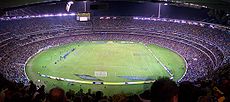 Australia and Greece playing an International Friendly at the MCG on 25 May 2006.
Australia and Greece playing an International Friendly at the MCG on 25 May 2006.
The agreement sees an annual fixture at the MCG, beginning with a clash between Australia and European champions Greece on 25 May 2006 in front of a sell-out crowd of 95,103, before Australia left to contest in the World Cup finals. Australia beat Greece 1–0. The Socceroos also hosted a match in 2007 against Argentina, losing 1–0, as well as 2010 FIFA World Cup qualification matches in 2009 against Asian Football heavyweights (Japan) which attracted 81,872 fans as Australia beat Japan 2–1 via 2 Tim Cahill trademark headers after falling behind 1–0 late in the 1st half. In 2010 it was announced that as a warm up to the 2010 FIFA World Cup which the Australians had qualified for, they would play fellow qualified nation New Zealand on 24 May at the MCG.
Other matches played at the MCG include the following:
- An exhibition match between Australia and Juventus played on 13 June 1984
- A 1998 FIFA World Cup qualifier between the Socceroos and Iran on Saturday 29 November 1997. The match was drawn 2–2, with Iran progressing on the away goal rule.
- An exhibition match between Manchester United and Australia on 15 July 1999.
- A friendly match between Brazil B and Australia on 17 November 1999.
- An Olympic Tournament group match between Italy and the Olyroos on 13 September 2000. Plus other preliminary matches during the Olympics which also included quarter final and the Semi final between Chile and Cameroon who went on to win the gold medal.
- A 2002 FIFA World Cup qualifier between the Australia and Uruguay on Tuesday 20 November 2001. The Socceroos won 1–0, however Uruguay progressed after later winning the second leg 3–0.
- A friendly match between Australia and than European champions, Greece – which was played as a warmup to the 2006 FIFA World Cup
- A friendly match between Australia and Argentina – Argentina had a full strength side with superstars such as Lionel Messi and Carlos Tévez
- A friendly match between Australia and the All Whites as a warm up before the 2010 FIFA World Cup in which Australia won in the very last play of the game.
Tennis
In 1878 the Melbourne Cricket Club’s Lawn Tennis Committee laid an asphalt court at the MCG and Victoria’s first game of tennis was played there. A second court of grass was laid in 1879 and the first Victorian Championship played on it in 1880. The first inter-colonial championship was played in 1883 and the first formal inter-state match between NSW and Victoria played in 1884 with Victoria winning.
In 1889 the MCC arranged for tennis to be played at the then Warehousemen’s Cricket Ground, now the Albert Ground, at Albert Park, rather than the MCG.
Cycling
It was at the MCG in 1869 that Australia’s first bicycle race was held. The event was for velocipedes, crude wooden machines with pedals on the front wheels. In 1898 the Austral Wheel Race was held at the MCG attracting a crowd of 30,000 to see cyclists race for a total of £200 in prize money.
Rugby league
Rugby league was first played at the ground on 15 August 1914, with a New South Wales team losing to England 15–21. The first ever rugby league State of Origin match at the MCG (and second in Melbourne) was played on 8 June 1994, attracting a then record league crowd in Australia of 87,161. Games were also played there in 1995 and 1997. The Melbourne Storm played two marquee games at the MCG in 2000. This was the first time that they had played outside of their normal home ground of Olympic Park Stadium which holds 18,500 people. Their first game was held on 3 March 2000 against the St. George Illawarra Dragons in a rematch of the infamous 1999 Grand Final. Anthony Mundine said they were 'not worthy premiers' and the Storm responded by running in 12 tries to two and winning 70–10 in front of 23,239 fans. This was their biggest crowd they had played against until 33,427 turned up to the 2007 Preliminary Final at Docklands Stadium. The record home and away crowd record has also been overhauled, when a match at Docklands in 2010 against St George attracted 25,480 spectators. Their second game attracted only 15,535 spectators and was up against the Cronulla Sharks on 24 June 2000. Once again, the Storm won 22–16.
Other uses
- Australia played New Zealand in rugby union at the MCG on 26 July 1997, losing 18–33 in front of a crowd of 90,119. and in 30 June 2007, Winning 20–15 in front of a crowd of 79,322.
- During World War II the stands were used by the Australian and American armies. It was used by the US Army Air Forces who moved into the MCG and gave the name of their base "Camp Murphy". It was also used by the First Division of the US Marine Corps, an RAAF Technical Training unit and as the RAAF Personnel Depot. The RAAF stayed at the MCG until 27 October 1945.
- Queen Elizabeth II visited the MCG in 1954 twice for an assembly and display. She attended a Richmond versus Fitzroy match on 5 April 1970, and also attended the Commonwealth Games Opening Ceremony at the ground on 15 March 2006.
- A record for attendance at the grounds was set by religious leader Billy Graham whose event in 1959 was attended by at least 130,000 people.
- The first rock concert to be held at the ground was one by David Cassidy in 1974. In 1978 David Bowie held a concert there. In 1993, Paul McCartney, U2 and Madonna held concerts, drawing huge crowds. The Rolling Stones held concerts in 1995, Michael Jackson in 1996, the Three Tenors in 1997, Elton John and Billy Joel in 1998.
- Pope John Paul II held a service at the MCG on 27 November 1986, and a celebration there of the Polish community the next day.
- The MCG hosted the 2007 Bledisloe Cup match during the Tri Nations series.
- The MCG hosted The Police with Special Guests Fergie & Fiction Plane on Australia Day 2008; the first MCG concert in 10 years.
- The MCG hosted Sound Relief, a concert donating all revenues to the Red Cross Victorian Bushfire Appeal with performances from Kings Of Leon, Midnight Oil, Split Enz, Paul Kelly, Hunters & Collectors, Wolfmother, Jet and Bliss N Eso, among others. It was held on 14 March 2009.
- On 5 November 2010, the MCG was the starting point for The Amazing Race Australia.[13]
All time highest attendance records at the MCG Number Attendance Event Date 1 130,000 Billy Graham Crusade 15 March 1959 2 121,696 VFL Grand Final Carlton v Collingwood 26 September 1970 3 120,000 40th Eucharistic Congress 25 February 1973 4 119,195 VFL Grand Final Carlton v Richmond 27 September 1969 5 118,192 VFL Grand Final Hawthorn v St Kilda 25 September 1971 Records
Sporting records
- First ever Test Cricket match (Australia v England) – 1877
- First ever One day international Cricket match – 1971
- Highest first class cricket score – 1107 (Victoria v NSW, 1926)
- Australia's first international Lacrosse match (Australia v Canada, 1907, 30,000)
- Fastest ball bowled in a Cricket match in Australia, 3rd fastest in the world – 160.7 km/h (Shaun Tait, Australia v Pakistan, 5 February 2010)
Attendance records
- Highest VFL/AFL attendance – 121,696 (Collingwood v Carlton, 1970)
- Highest soccer crowd in Australia – 107,000 (1956 Olympics Soccer Final)[citation needed]
- Highest Australian soccer crowd – 95,103 (Australia v Greece, 2006)
- Highest single-day attendance in the history of Test Cricket – 90,800 in 1961 (Australia v West Indies)
- Highest One Day International crowd – 87,182 (1992 World Cup Final England v Pakistan)
- Highest Australian religious event attendance – 130,000–140,000 (Billy Graham crusade, 1959)
- The first stadium in the world to have its annual number of visitors equal to the city's population[citation needed]
Stadium records
- World's first all colour cricket scoreboard with instant replays
- World's first electronic sightscreens
- World's first super sopper
- World's first scrolling signage at an oval-shaped ground
- First time an international Cricket match was played on a one-piece portable pitch, Boxing Day Test, 2000
- World's highest light towers[citation needed]
Cricket Records
Test Records
- Highest Test Total: 604 – Australia vs. England, 26 February 1937
- Highest Individual Test Score: 307 – Bob Cowper, Australia vs. England, 11 February 1966
- Best Test Innings Bowling Figures: 9/86 – Sarfraz Nawaz, Pakistan vs. Australia, 10 March 1979
- Best Test Match Bowling Figures: 15/124 – Wilfred Rhodes, England vs. Australia, 1 January 1904
- Highest Test Partnership: 346 (for the 6th wicket) – Sir Donald Bradman & Jack Fingleton, Australia vs. England, 1 January 1937
ODI Records
- Highest ODI Total: 8/344 – ICC World XI vs. ACC Asian XI, World Cricket Tsunami Appeal, 10 January 2005
- Highest Individual ODI Score: 173 – Mark Waugh, Australia vs. West Indies, 9 February 2001
- Best ODI Innings Bowling Figures: 6/42 – Ajit Agarkar, India vs. Australia, 9 January 2004
- Highest ODI Partnership: 225 (for the 2nd wicket) – Adam Gilchrist & Ricky Ponting, Australia vs. England, 15 December 2002
Twenty20 International Records
- Highest Twenty20 Total: 9/182 – Australia vs. South Africa, 11 January 2009
- Highest Individual Twenty20 Score: 89 (43) – David Warner, Australia vs. South Africa, 11 January 2009
- Best Twenty20 Innings Bowling Figures: 3/11 – Nathan Bracken, Australia vs. India, 1 February 2008
- Highest Twenty20 Partnership: 60 (for the 1st wicket) – Ian Bell & Steven Davies, England vs. Australia, 14 January 2011
Parade of Champions
Outside of the MCG are statues of famous Australian athletes donated by Tattersalls and known as the Parade of Champions, including many Australian rules football and cricket legends.
They include:
- Ron Barassi (Australian rules football player)
- Dick Reynolds (Australian rules football player)
- Leigh Matthews (Australian rules football player)
- Haydn Bunton, Sr. (Australian rules football player)
- Don Bradman (cricket player)
- Keith Miller (cricket player)
- Bill Ponsford (cricket player)
- Dennis Lillee (cricket player)
- Betty Cuthbert (track and field)
- Shirley Strickland (track and field)
There is also a statue depicting the first game of Australian rules football and the nearby Punt Road Oval has a statue of Jack Dyer.
See also
- Australian landmarks
- History of Test cricket (to 1883)
- History of Test cricket (1884 to 1889)
- History of Test cricket (1890 to 1900)
- List of Test cricket grounds
- List of international cricket centuries at the Melbourne Cricket Ground
- National Sports Museum, a museum dedicated to Australian sport, located within the Melbourne Cricket Ground
References
- ^ "MCG Facts and Figures". Melbourne Cricket Ground. 2009. http://www.mcg.org.au/The%20MCG%20Stadium/Facts%20and%20Figures.aspx. Retrieved 26 December 2009.
- ^ Chappell, Ian (26 December 2010). "Heroes wanted: Apply at the 'G". Herald Sun. http://www.heraldsun.com.au/ipad-application/heroes-wanted-apply-at-the-g/story-fn6bn647-1225975914380. Retrieved 29 December 2010.
- ^ "Melbourne Cricket Ground, Victorian Heritage Register (VHR) Number H1928, Heritage Overlay HO890". Victorian Heritage Database. Heritage Victoria. http://vhd.heritage.vic.gov.au/vhd/heritagevic#detail_places;1538.
- ^ Australian National Heritage listing for the Melbourne Cricket Ground
- ^ Top sporting wonders of the world.
- ^ John Brumby announces $55m facelift for MCG's Great Southern Stand Herald Sun 15 September 2010
- ^ Australia v England in 1882/83 (2003). Cricket Archive
- ^ Australia v England in 1882/83 IFW Bligh's XI in Australia 1882/83 (2nd Test) (2003). Cricket Archive
- ^ List of ODI matches. Cricinfo.com
- ^ 1956 Summer Olympics official report. p. 40.
- ^ 2000 Summer Olympics official report. Volume 1. p. 393.
- ^ "Melbourne football club sees surge in popularity". Australian Broadcasting Corporation. 29 June 2006. http://www.abc.net.au/worldtoday/content/2006/s1674867.htm.
- ^ "Amazing Race Australia filming in Melbourne". The Spy Report. 5 November 2010. http://www.mediaspy.org/report/2010/11/05/amazing-race-australia-filming-in-melbourne/. Retrieved 24 January 2011.
Further reading
- Cashman, Richard (1995) Paradise of Sport Melbourne: Oxford University Press
- Cuthbert, Betty (1966) Golden Girl
- Gordon, Harry (1994) Australia and the Olympic Games Brisbane: University of Queensland Press
- Hinds, Richard (1997) Low blows. Sport’s top 10 The Sydney Morning Herald 1 November
- Linnell, Garry (1995) Football Ltd Sydney: Ironbark Pan Macmillan Australia
- Pollard, Jack (1990) Australia Test Match Grounds London: Willow Books
- Plan of the Town and Suburbs of Melbourne 1843
- Vamplew, Wray; Moore, Katharine; O’Hara, John; Cashman, Richard; and Jobling, Ian [editors] (1997) The Oxford Companion to Australian Sport Second Edition Melbourne: Oxford University Press
External links
- MCG Official website
- Virtual tour of the Melbourne Cricket Ground
- Description at sportsvenue-technology.com
- Melbourne Cricket Ground at Austadiums
- "Around the Grounds" – Web Documentary – MCG
Summer Olympic stadia Athens 1896 • Paris 1900 • St Louis 1904 • London 1908 • Stockholm 1912 • Antwerp 1920 • Paris 1924 • Amsterdam 1928 • Los Angeles 1932 • Berlin 1936 • London 1948 • Helsinki 1952 • Melbourne 1956 • Rome 1960 • Tokyo 1964 • México City 1968 • Munich 1972 • Montréal 1976 • Moscow 1980 • Los Angeles 1984 • Seoul 1988 • Barcelona 1992 • Atlanta 1996 • Sydney 2000 • Athens 2004 • Beijing 2008 • London 2012 • Rio de Janeiro 2016Venues of the 1956 Summer Olympics Melbourne Broadmeadows · Hockey Field · Lake Wendouree · Melbourne Cricket Ground · Oaklands Hunt Club · Olympic Park Stadium · Port Phillip · Royal Australian Air Force, Laverton Air Base · Royal Exhibition Building · St Kilda Town Hall · Swimming/Diving Stadium · Velodrome · West Melbourne Stadium · WilliamstownStockholm Venues of the 2000 Summer Olympics Sydney Olympic Park NSW Tennis Centre · Olympic Stadium · State Hockey Centre · State Sports Centre · Sydney Showground (Sydney Baseball Stadium) · Sydney International Archery Park · Sydney International Aquatic Centre · Sydney Super DomeSydney Blacktown Olympic Park · Bondi Beach · Centennial Parklands · Dunc Gray Velodrome · Fairfield City Farm · Marathon course · North Sydney · Olympic Sailing Shore Base · Penrith Whitewater Stadium · Ryde Aquatic Leisure Centre · Sydney Convention and Exhibition Centre · Sydney Entertainment Centre · Sydney Football Stadium · Sydney International Equestrian Centre · Sydney International Regatta Centre · Sydney International Shooting Centre · Sydney Opera HouseOutside Sydney Brisbane Cricket Ground · Bruce Stadium (Canberra) · Hindmarsh Stadium (Adelaide) · Melbourne Cricket Ground1908: White City Stadium • 1920: Olympisch Stadion • 1928: Old Stadion • 1932: Olympic Stadium • 1936: Hockey Stadion (final), Hockey Stadion #2 • 1948: Empire Stadium (medal matches), Guinness Sports Club, Lyons' Sports Club, Polytechnic Sports Ground • 1952: Velodrome • 1956: Hockey Field, Melbourne Cricket Ground (final) • 1960: Campo Tre Fontane, Olympic Velodrome (final), Stadio dei Marmi • 1964: Komazawa Hockey Field • 1968: Municipal Stadium • 1972: Hockeyanlage • 1976: Molson Stadium, McGill University • 1980: Dynamo Central Stadium, Minor Arena; Young Pioneers Stadium (final) • 1984: Weingart Stadium • 1988: Seongnam Stadium • 1992: Estadi Olímpic de Terrassa • 1996: Clark Atlanta University Stadium, Morris Brown College Stadium (final) • 2000: State Hockey Centre • 2004: Olympic Hockey Centre • 2008: Olympic Green Hockey Field • 2012: Olympic Hockey Centre • 2016: Olympic Hockey Center
List of Olympic venues in football 1900: Vélodrome de Vincennes · 1904: Francis Field · 1908: White City Stadium · 1912: Råsunda Stadium, Stockholm Olympic Stadium (final), Traneberg · 1920: Jules Ottenstadion, Olympisch Stadion (final), Stade Joseph Marien, Stadion Broodstraat · 1924: Stade Bergeyre, Stade de Colombes (final), Stade de Paris, Stade Pershing · 1928: Monnikenhuize, Olympic Stadium (final), Sparta Stadion Het Kasteel · 1936: Hertha-BSC Field, Mommsenstadion, Olympic Stadium (final), Poststadion · 1948: Arsenal Stadium, Champion Hill, Craven Cottage, Cricklefield Stadium, Empire Stadium (medal matches), Green Pond Road, Griffin Park, Selhurst Park, White Hart Lane · 1952: Helsinki Football Grounds, Kotka, Lahti, Olympic Stadium (final), Tampere, Turku · 1956: Melbourne Cricket Ground (final), Olympic Park Stadium · 1960: Florence Communal Stadium, Grosseto Communal Stadium, L'Aquila Communal Stadium, Livorno Ardenza Stadium, Naples Saint Paul's Stadium, Pescara Adriatic Stadium, Stadio Flaminio (final) · 1964: Komazawa Olympic Park Stadium, Mitsuzawa Football Field, Osaka Nagai Stadium, Tokyo National Stadium (final), Nishikyogoku Athletic Stadium, Ōmiya Football Field, Prince Chichiba Memorial Football Field · 1968: Estadio Azteca (final), Estadio Cuauhtémoc, Estadio Nou Camp, Jalisco Stadium · 1972: Drei Flüsse Stadion, ESV-Stadion, Jahnstadion, Olympiastadion (final), Rosenaustadion, Urban Stadium · 1976: Lansdowne Park, Olympic Stadium (final), Sherbrooke Stadium, Varsity Stadium · 1980: Dynama Stadium, Dynamo Central Stadium, Grand Arena, Grand Arena (final), Kirov Stadium, Republican Stadium · 1984: Harvard Stadium, Navy – Marine Corps Memorial Stadium, Rose Bowl (final), Stanford Stadium · 1988: Buson Stadium, Daegu Stadium, Daejeon Stadium, Dongdaemun Stadium, Olympic Stadium (final) · 1992: Estadi de la Nova Creu Alta, Estadi del FC Barcelona (final), Estadio Luís Casanova, La Romareda, RCD Espanyol Stadium · 1996: Florida Citrus Bowl, Legion Field, Orange Bowl, RFK Memorial Stadium, Sanford Stadium (final) · 2000: Brisbane Cricket Ground, Bruce Stadium, Hindmarsh Stadium, Melbourne Cricket Ground, Olympic Stadium (men's final), Sydney Football Stadium (women's final) · 2004: Kaftanzoglio Stadium, Karaiskakis Stadium, Olympic Stadium (final), Pampeloponnisiako Stadium, Pankritio Stadium, Panthessaliko Stadium · 2008: Beijing National Stadium (final), Qinhuangdao Olympic Sports Center Stadium, Shanghai Stadium, Shenyang Olympic Sports Center Stadium, Tianjin Olympic Center Stadium, Workers Stadium · 2012: City of Coventry Stadium, Hampden Park, Millennium Stadium, St James' Park, Wembley Stadium (final) · 2016: Estádio Nacional de Brasília, Arena Fonte Nova, Estádio do Maracanã, Mineirão, Estádio do Morumbi Hamilton, 1930 · London, 1934 · Sydney, 1938 · Auckland, 1950 · Vancouver, 1954 · Cardiff, 1958 · Perth, 1962 · Kingston, 1966 · Edinburgh, 1970 · Christchurch, 1974 · Edmonton, 1978 · Brisbane, 1982 · Edinburgh, 1986 · Auckland, 1990 · Victoria, 1994 · Kuala Lumpur, 1998 · Manchester, 2002 · Melbourne, 2006 · New Delhi, 2010 · Glasgow, 2014 · Gold Coast, 2018
Hamilton, 1930 · London, 1934 · Sydney, 1938 · Auckland, 1950 · Vancouver, 1954 · Cardiff, 1958 · Perth, 1962 · Kingston, 1966 · Edinburgh, 1970 · Christchurch, 1974 · Edmonton, 1978 · Brisbane, 1982 · Edinburgh, 1986 · Auckland, 1990 · Victoria, 1994 · Kuala Lumpur, 1998 · Manchester, 2002 · Melbourne, 2006 · New Delhi, 2010 · Glasgow, 2014 · Gold Coast, 2018Test cricket grounds in Australia Primary Test grounds: Adelaide Oval · Bellerive Oval · The Gabba · Melbourne Cricket Ground · Sydney Cricket Ground · WACA GroundSecondary Test grounds: Former Test grounds: Australian Football League grounds Main grounds: Carrara Stadium · Docklands Stadium · Football Park · The Gabba · Kardinia Park · Melbourne Cricket Ground · Stadium Australia · Subiaco Oval · Sydney Cricket GroundNeutral grounds: Future grounds: Defunct and
disused grounds:Arden Street Oval · Brunswick Street Oval · Coburg Oval · Corio Oval · East Melbourne Cricket Ground · Glenferrie Oval · Junction Oval · Lake Oval · Moorabbin Oval · Motordrome · Princes Park · Punt Road Oval · Toorak Park · Victoria Park · WACA Ground · Waverley Park · Whitten Oval · Windy Hill · Yarraville OvalInternational Rules Series Tours Series Past Venues AustralianCanberra Stadium | Carrara Stadium | Docklands Stadium | Football Park | Melbourne Cricket Ground | Subiaco Oval | WACA Ground | Waverley ParkIrishParticipants Landmarks in the Melbourne City Centre Note: this includes landmarks in the Melbourne City Centre and its fringe areas, not the Greater Melbourne metropolitan areaCity Precincts Arts Precinct · Chinatown · Docklands · Government Precinct · Greek Precinct · Little Italy · Paris End · RMIT City · Southbank/Wharf · Sports and Entertainment Precinct · University of MelbourneShopping Block Arcade · Bourke Street · Bridge Road · Brunswick Street · Chapel Street · Collins Street · DFO South Wharf · Elizabeth Street · Flinders Lane · Docklands Harbour Town · Lt. Collins Street · Melbourne Central Shopping Centre · Myer Emporium · Melbourne GPO · Queen Victoria Market · Queen Victoria Village · Royal Arcade · Swanston Street
Entertainment Colonial Tramcar Restaurant · Crown Casino and Entertainment Complex · Luna Park · Melbourne Aquarium · City Tourist Shuttle · Melbourne Zoo · See also: Events in the Melbourne City Centre · Theatres in the Melbourne City Centre
Public Galleries Australian Centre for Contemporary Art · Australian Centre for the Moving Image · National Gallery of Victoria, inc. Ian Potter Centre · State Library of Victoria's Cowen Gallery, Dome Gallery and Murdoch Gallery · RMIT Gallery · See also: Museums in the Melbourne City Centre
Institutions General Post Office · Government House · Melbourne Observatory · Melbourne Town Hall · Old Melbourne Gaol · Old Melbourne Mint · Old Melbourne Magistrates' Court · Old Treasury Building · Parliament House · State Library of Victoria · Supreme Court of Victoria · Victoria Barracks
Structures Sports Stadia Melbourne Rectangular Stadium (AAMI Park) · Docklands Stadium (Etihad Stadium) · Flemington Racecourse · Melbourne Multi Purpose Venue (Hisense Arena) · Melbourne Cricket Ground (MCG) · Melbourne Grand Prix Circuit · Melbourne Sports and Aquatic Centre (MSAC) · National Ice Sports Centre (The Icehouse) · Olympic Park Stadium · Rod Laver Arena · Royal Melbourne Golf Club · Princes Park (Visy Park)
Parks/Spaces Albert Park and Lake · Alexandra Gardens · Birrarung Marr · Carlton Gardens · City Square · Federation Square · Fitzroy Gardens · Flagstaff Gardens · Kings Domain · Queen Victoria Gardens · Royal Botanic Gardens · Royal Park · Treasury Gardens · Yarra Park
Transport Bolte Bridge · Capital City Trail · City Circle Tram · CityLink · Flinders Street Station · Melbourne Airport · Melbourne Seaport · Southern Cross Station · Trams in Melbourne · West Gate Bridge
See also: Events in the Melbourne City Centre · Museums in the Melbourne City Centre · Theatres in the Melbourne City CentreCategories:- Landmarks in Melbourne
- Australian Football League grounds
- Test cricket grounds in Australia
- Athletics venues in Australia
- Music venues in Australia
- Olympic stadiums
- Olympic athletics venues
- Olympic field hockey venues
- Olympic football venues
- Soccer venues in Australia
- National stadiums
- 2000 Summer Olympic venues
- 2006 Commonwealth Games venues
- Stadiums of the Commonwealth Games
- 1956 Summer Olympic venues
- Australian National Heritage List
- Melbourne Football Club
- Victorian Heritage Register
- Cricket grounds in Australia
Wikimedia Foundation. 2010.



